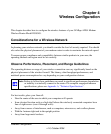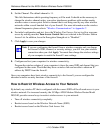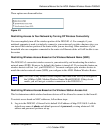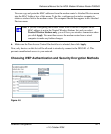
Reference Manual for the ADSL Modem Wireless Router DG834G
4-6 Wireless Configuration
v1.2, October 2006
— Wireless Isolation. If enabled, Wireless Stations will not be able to communicate with
each other or with Stations on the wired network. This feature should normally be
disabled.
• Wireless Station Access List.
— By default, any wireless computer that is configured with the correct wireless network
name or SSID will be allowed access to your wireless network. For increased security, you
can restrict access to the wireless network to only specific computers based on their MAC
addresses. Click Setup Access List to display the Wireless Station Access List menu.
• Security Options
Table 4-1. Wireless Security Options
Field Description
Disable
Wireless security is not used.
WEP (Wired
Equivalent
Privacy)
You can select the following WEP options:
Authentication Type
• Open: the DG834G v3 does not perform any authentication.
• Shared: WEP shared key authentication. For a full explanation of WEP shared key,
see “Wireless Communications” in Appendix C.
Encryption Strength
• If Shared or Open Network Authentication is enabled, you can choose 64- or 128-bit
WEP data encryption.
Note: With Open Network Authentication and 64- or 128-bit WEP Data Encryption, the
DG834G v3 does perform 64- or 128-bit data encryption but does not perform any
authentication.
Security Encryption (WEP) Key
These key values must be identical on all wireless devices in your network (key 1 must
be the same for all, key 2 must be the same for all, and so on).
The DG834G v3 provides two methods for creating WEP encryption keys:
• Passphrase. These characters are case sensitive. Enter a word or group of printable
characters in the Passphrase box and click the Generate button.
Note: Not all wireless adapters support passphrase key generation.
• Manual. These values are not case sensitive.
64-bit WEP: enter 10 hexadecimal digits (any combination of 0-9, a-f, or A-F).
128-bit WEP: enter 26 hexadecimal digits (any combination of 0-9, a-f, or A-F).


















